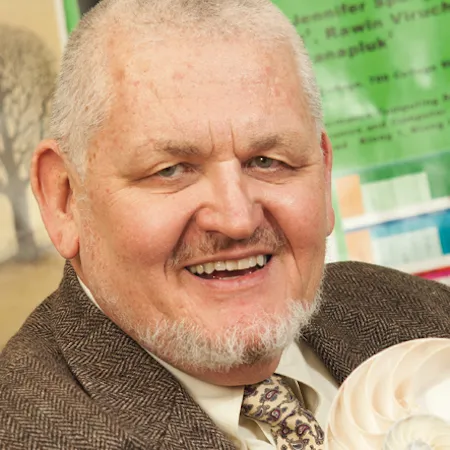Computational Biological Visualization, Quantitative Image Analysis & Exploring Complex Data
Analyses of multivariate, multi-scale nonlinear phenomena require new tools and conceptual approaches. How do we help viewers interpret and appreciate irregular, asymmetric patterns that occur in biological images and complex networks? Image analysis and graph theory that allow users to test hypotheses about causal mechanisms about how images and networks are formed are particularly powerful. In addition, they also help reduce the topological dimension of data so that subpatterns can be identified. However, image and network analyses without a mathematical model usually means that basic descriptive statistics are collected that re-describe properties of an image without actually testing a causal hypothesis. In this seminar, Dr. John Jungck will illustrate four models that instantiate the paleontologist Dolph Seilacher’s dictum: “I wouldn’t have seen it, if I hadn’t believed it.” Thus, mathematics is a lens that helps us see from a perspective. In particular, Jungck believes that if the mathematics is easily accessible to biologists, then they are not only apt to use it, but also to understand how it helps them with their work. Jungck will demonstrate five software applications that have been developed based upon geometry, spatial statistics, graph theory, cellular automata, and fractals to problems of differentiating normal from abnormal cell divisions, adaptive geometry of trees, food webs, root growth, biofilms, pattern formation, species transformations, and morphospace. In particular, he will illustrate how three DRYAD data sets from NESCent have been used to build interactive exploratory problem spaces.
Presenters

John Jungck
Dr. John Jungck is a theoretical biologist who specializes in molecular evolution, evolutionary bioinformatics, image analysis, and mathematical biology education. His interests are deeply involved with various aspects of promoting interdisciplinary work: science, technology, and society; history, philosophy, and social studies of biology; art and science (STEAM – putting art in Science, Technology, Engineering, and Mathematics); numeracy (quantitative reasoning); Citizen Science and Participatory Democracy; international collaboration (International Union of Biological Sciences); mathematics...

John Jungck
Dr. John Jungck is a theoretical biologist who specializes in molecular evolution, evolutionary bioinformatics, image analysis, and mathematical biology education. His interests are deeply involved with various aspects of promoting interdisciplinary work: science, technology, and society; history, philosophy, and social studies of biology; art and science (STEAM – putting art in Science, Technology, Engineering, and Mathematics); numeracy (quantitative reasoning); Citizen Science and Participatory Democracy; international collaboration (International Union of Biological Sciences); mathematics and science education (PBL, collaborative learning, open ended investigations, strategic simulations for learning long-term strategies of research, problem solving, interdisciplinary education, progressive cyberlearning); and promoting diversity and student retention. He was the co-founder of the BioQUEST Curriculum Consortium. Much of his career has included serving the community as an editor of journals that range from the Bulletin of Mathematical Biology, Evolutionary Bioinformatics, and BioSystems to Biology International, Bioscene: Journal of College Biology Teaching, the American Biology Teacher, and the American Journal of Undergraduate Research.